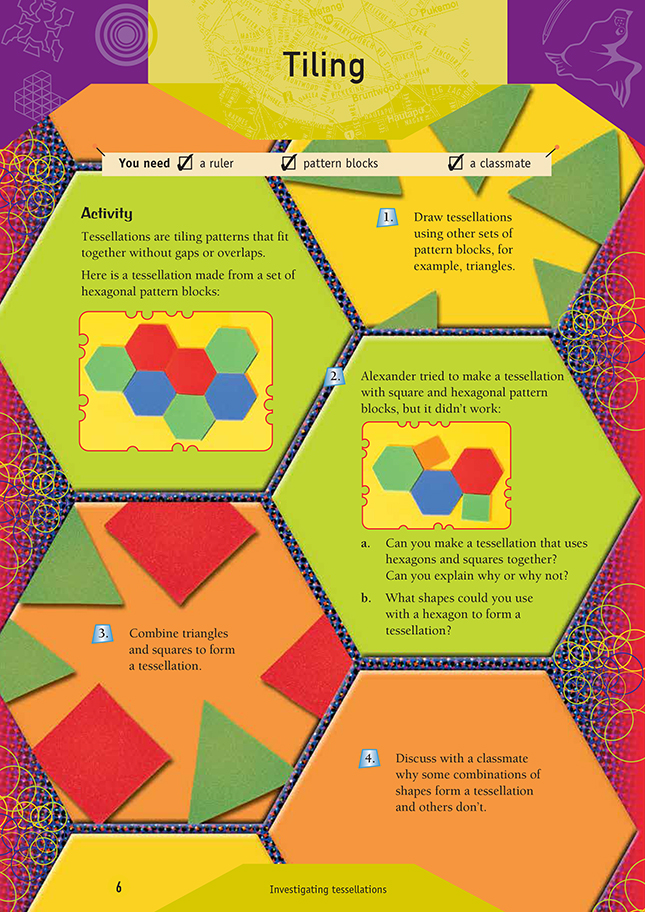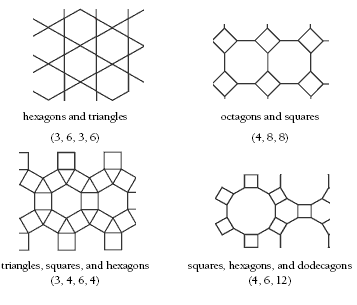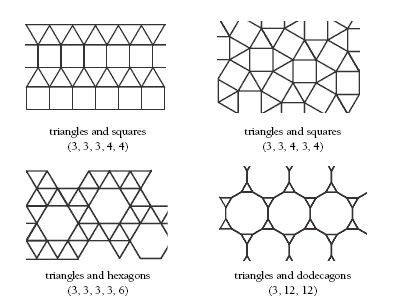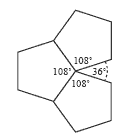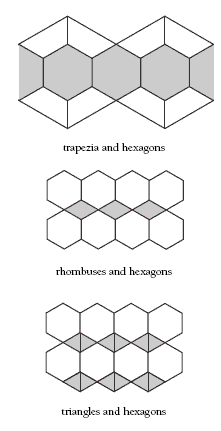This is a level 3-4 geometry strand activity from the Figure it Out series.
A PDF of the student activity is included.
Click on the image to enlarge it. Click again to close. Download PDF (291 KB)
make and describe a tessellation pattern
describe a tessellation pattern using interior angles
pattern blocks
ruler
FIO, Level 3-4, Geometry, Tiling, page 6
classmate
In this activity, students create a tessellation, which is a design made up of repeated tiles with no overlap or gaps. Tessellations are also known as plane tilings because they continue in every direction and so cover the plane. The students should be able to easily tessellate regular shapes.
The first example on the student page, a tessellation made from hexagonal pattern blocks, is a regular tessellation because the polygon is regular and identical.
There are three regular tessellations. They are:
A second group of tessellations is classified as semi-regular tessellations. All the polygons are regular, but there are two or more different polygons in the tessellation. The numbers under each tessellation below list in order the number of sides in the polygons that meet at a vertex. For example, the (3, 6, 3, 6) under the first example indicates that the tessellation is formed by placing a triangle, a hexagon,
a triangle, and a hexagon together at a vertex.
There are eight semi-regular tessellations. They are:
In questions 2 and 3, the students need to experiment with combinations of shapes and then look carefully at their patterns to find reasons why the chosen shapes do or do not tessellate. In question 4, they discuss this with a classmate.
To understand why some shapes tessellate and others do not, the students need to have examined the interior angles of polygons. The activity on page 5 covers this. They need to remember that the interior angles of a triangle add up to 180° and each extra vertex in a shape adds another 180° to the total.
To explain why some shapes tessellate and others do not, the students will need to understand what interior angles are and to know that the sum of the interior angles meeting at a vertex must equal 360°. If they understand this, they will be able to explain why the three regular tessellations (equilateral triangles, squares, and hexagons) work, whereas pentagons do not tessellate. For example, the pentagon has five sides and its interior angles add up to 540°. So each interior angle is
108°. The interior angles of three pentagons placed together do not add up to 360° at the vertex, so they will not tessellate.
The students should use similar reasoning to explain why some combinations of shapes tessellate and others do not.
Answers to Activity
1. Drawings will vary, but all sets of pattern blocks can be made into tessellations.
2. a. No, it is not possible to make a tessellation
with hexagons and squares. The inside (interior) angles of the polygons that meet
at each point do not add up to 360°.
b. You could use trapezia, rhombuses, or triangles with hexagons to make a
tessellation. For example:
3. A tessellation with triangles and squares could look like this:
4. Side lengths that meet must be the same and the interior angles of the shapes about a point must add up to 360°. If the shapes do not meet both of these requirements, they will not tessellate.
